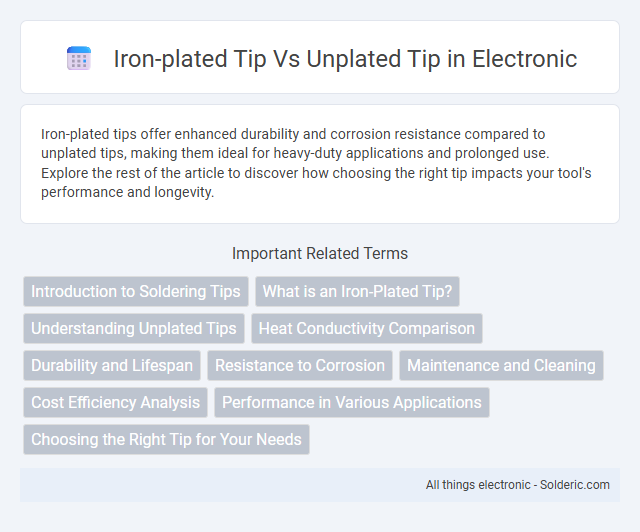Iron-plated tips offer enhanced durability and corrosion resistance compared to unplated tips, making them ideal for heavy-duty applications and prolonged use. Explore the rest of the article to discover how choosing the right tip impacts your tool's performance and longevity.
Comparison Table
| Feature | Iron-Plated Tip | Unplated Tip |
|---|---|---|
| Durability | Higher resistance to wear and corrosion | Lower durability, prone to rust |
| Heat Conductivity | Improved heat transfer for efficient soldering | Standard conductivity, less efficient |
| Maintenance | Requires less frequent cleaning and replacement | Needs regular cleaning and faster replacement |
| Cost | Typically higher initial cost | Lower upfront expense |
| Oxidation Resistance | Better resistance to oxidation | More susceptible to oxidation |
Introduction to Soldering Tips
Iron-plated soldering tips offer enhanced durability and corrosion resistance compared to unplated tips, ensuring longer-lasting performance during extended soldering tasks. Unplated tips, while often less expensive, tend to oxidize quickly, reducing heat transfer efficiency and requiring more frequent replacement. Selecting an iron-plated tip optimizes Your soldering accuracy and longevity, especially when working with diverse electronic components.
What is an Iron-Plated Tip?
An iron-plated tip consists of a layer of iron coating applied to the surface of a tool tip, enhancing its hardness, wear resistance, and durability compared to an unplated tip. This plating process improves the tool's performance by reducing friction and protecting against corrosion, which extends the lifespan during heavy-duty applications. Your choice between iron-plated and unplated tips depends on the specific demands of your tasks and the need for long-lasting precision.
Understanding Unplated Tips
Unplated tips lack the protective iron plating that enhances durability and corrosion resistance in iron-plated tips, making them more prone to wear and rust over time. The absence of plating can result in shorter tool lifespan and less effective performance in high-friction or high-heat applications. Selecting the appropriate tip depends on the intended use, with unplated tips being suitable for lighter tasks or where cost efficiency is prioritized.
Heat Conductivity Comparison
Iron-plated tips exhibit significantly higher heat conductivity compared to unplated tips, enabling faster and more consistent heat transfer during soldering tasks. This enhanced thermal performance reduces the risk of cold joints and improves overall work efficiency by maintaining a stable temperature at the soldering point. Unplated tips, lacking the conductive iron coating, often show slower heat response and uneven temperature distribution, impacting soldering quality.
Durability and Lifespan
Iron-plated tips offer significantly enhanced durability compared to unplated tips, as the iron coating provides a hard, protective layer that resists wear and corrosion. This results in a longer lifespan, allowing your tools or components to maintain performance and integrity even under frequent or heavy use. Choosing an iron-plated tip improves reliability and reduces the need for frequent replacements, optimizing overall product longevity.
Resistance to Corrosion
Iron-plated tips exhibit significantly higher resistance to corrosion compared to unplated tips due to the protective layer of iron oxide formed on their surface. This iron oxide barrier prevents moisture and environmental elements from directly contacting the underlying metal, reducing rust and degradation. Unplated tips lack this protective coating, making them more susceptible to rapid corrosion and shorter lifespan in harsh conditions.
Maintenance and Cleaning
Iron-plated tips offer enhanced durability and resist corrosion, making maintenance and cleaning easier compared to unplated tips, which may rust or wear down faster. Proper cleaning of iron-plated tips typically requires only gentle wiping with a damp cloth and occasional deoxidizing solutions, while unplated tips often need frequent polishing to prevent oxidation buildup. Ensuring your tool uses an iron-plated tip can significantly reduce downtime for cleaning and prolong overall lifespan.
Cost Efficiency Analysis
Iron-plated tips offer greater durability, reducing the frequency of replacements and lowering long-term maintenance costs compared to unplated tips, which wear out faster and require more frequent replacement. The initial investment for iron-plated tips is higher, but improved lifespan and performance results in overall cost savings. Unplated tips have lower upfront costs but incur higher total expenses due to increased wear and reduced operational efficiency.
Performance in Various Applications
Iron-plated tips demonstrate enhanced durability and corrosion resistance compared to unplated tips, making them ideal for high-wear applications such as industrial soldering and heavy-duty mechanical tasks. The plating provides a protective layer that extends tool life by reducing oxidation and wear, improving performance consistency in harsh environments. Unplated tips, while cost-effective, tend to degrade faster under intensive use, limiting their effectiveness in precision applications requiring sustained heat transfer or mechanical stability.
Choosing the Right Tip for Your Needs
Selecting between an iron-plated tip and an unplated tip hinges on durability and application precision. Iron-plated tips offer enhanced resistance to corrosion and wear, making them ideal for high-frequency use and environments prone to oxidation. Unplated tips provide a more cost-effective choice with sufficient performance for occasional tasks but may require more frequent replacement due to faster degradation.
iron-plated tip vs unplated tip Infographic

 solderic.com
solderic.com